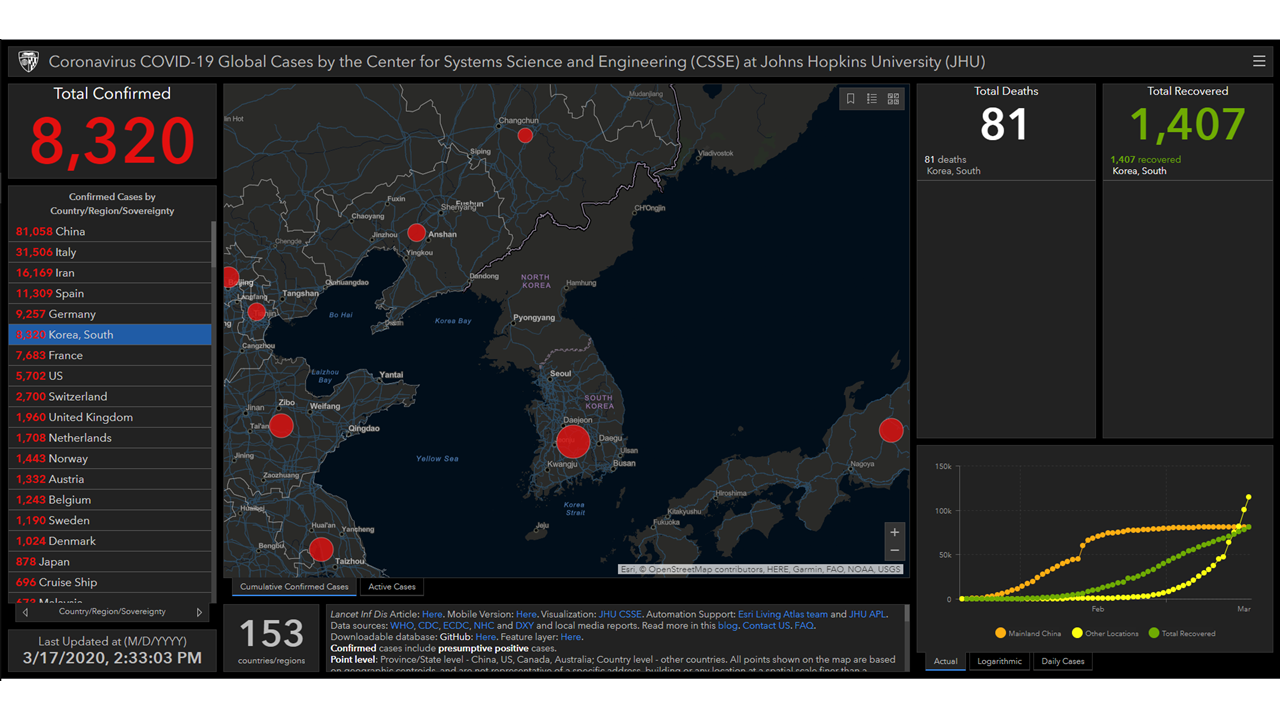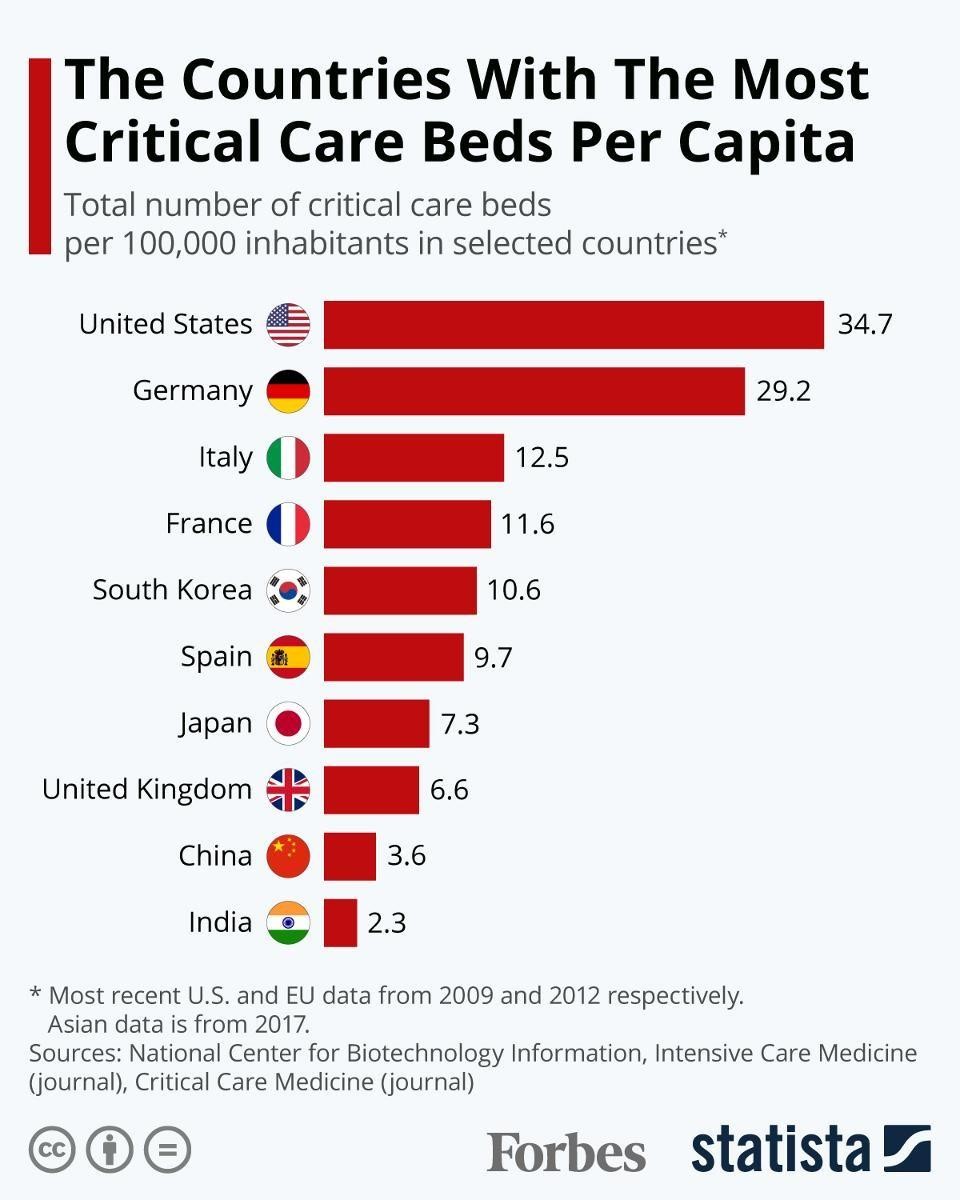Mounting evidence suggests that if you don’t smoke or aren’t 70 or older or have underlying health conditions, you’ll be fine—although you can spread it to other, more vulnerable people.
The latest information on Coronavirus COVID-19, also known as the Wuhan Flu, from Johns Hopkins University shows widely varying numbers of confirmed cases and apparent mortality rates by nation.
The People’s Republic of China, the virus’ epicenter, was reporting 81,058 cases as of March 17 with 3,230 deaths, with 4.0 percent of those diagnosed subsequently dying. Italy is similarly hard hit, with 31,506 cases and 2,503 deaths for a mortality rate of 7.9 percent of those diagnosed.
Yet South Korea, a nation with frequent, direct contact with people from China, is only showing 8,320 cases of COVID-19 with 81 deaths, a rate of 1.0 percent—likely not too different than can be expected every year from common influenza if one considers the many mild cases who didn’t present to medical personnel.
Different Countries, Different Results
So, why the huge differences in diagnosed cases and mortality, and what does that mean for America? Important factors to consider are government (both competence and transparency), the state of the health-care system (the number of people tested and its critical care system), and the affected population (its age and health).
A stark example of this can be seen in the two Koreas, one free and prosperous, the other enslaved and poor. South Korea’s 8,320 confirmed cases of the Wuhan Flu contrast with none in North Korea.

This is a pathogenic impossibility. The COVID-19 numbers out of North Korea are not to be believed for the same reason the survival rate for any North Korean who criticizes paramount leader Kim Jong-un approaches zero: the government controls all information on penalty of death.
Similarly, the People’s Republic of China has a casual association with the truth related to a virus that was first diagnosed in and around the city of Wuhan in Hubei province. In December, Li Wenliang, a Chinese ophthalmologist at Wuhan Central Hospital, used the WeChat app to warn the medical community about what he thought was an outbreak of a SARS-like (severe acute respiratory syndrome) illness.
SARS is a coronavirus. Li was quickly contacted by police, who admonished him to “stop making false comments.” He was subsequently investigated for “spreading rumors.” Within four days he was ordered to appear at the Public Security Bureau, where he had to sign a false confession that he “severely disturbed the social order.” Local officials later apologized to Li, just before he died from the virus.
At the same time, some 100 miles across the Taiwan Strait, the freely elected Taiwanese government has reported 77 confirmed cases of COVID-19 with one death. Had Taiwan suffered a similar infection level and reported death rate as on mainland China, it would be reporting about 1,400 cases and 56 deaths.
The reporting out of China suggests the Chinese Communist Party is artificially pushing the new infections rate down, reporting fewer than 1,000 new cases in the past two weeks while the number of cases reported worldwide exceeded that in China on March 15 at 81,700 and is now rising rapidly. It is highly likely that the total infections numbers out of China cannot be trusted. In fact, Chinese authorities have been highly effective in preventing independent reporting out of Wuhan, forcing the outside world to rely solely on Beijing’s word.
So, should Americans be worried? Mounting evidence suggests that if you don’t smoke or aren’t 70 or older or have underlying health conditions, you’ll be fine—although you can spread it to other, more vulnerable people.
Risk Factors Vary by Person and Country
Some 319 million people in China smoke, about 23 percent of the population. In Italy, 19 percent of the population smokes. In South Korea, 40.7 percent of the male population smokes compared to 6.4 percent of the females. By comparison, about 37.8 million Americans smoke—18 percent of men and 14 percent of women.
Italy’s mortality numbers are further burdened by agedness. Italy has one of the oldest populations in the world, with almost 60 percent of Italians aged 40 and up and a national average age of 46. The median age in the United States is 38.2 years.
Even so, conflicting reports out of Italy suggest there may only be two people who died from the coronavirus who did not also present other pathologies. This, as Silvio Brusaferro, the president of the Higher Institute of Health in Rome, noted that, “Positive deceased patients have an average of over 80 years—80.3 to be exact—and are essentially predominantly male.” Only 25.8 percent of deaths attributed to the virus were women.
Lastly, when the virus makes Americans sick enough to seek medical attention, there’s one more advantage we have: the U.S. has almost three times the critical care beds per capita as does Italy, more than triple what South Korea has (where the death rate may be close to that of the flu, depending the number of mild, undiagnosed cases), and almost 10 times that in China.

Even as the Trump administration and state and local officials enact prudent measures and provide guidance to mitigate the rapid spread of the virus, coronavirus-induced panic may be overwrought. America will emerge just fine after the epidemic passes, and with some lasting benefits: a greater acceptance of telecommuting and distance learning.
Don’t Believe the Hype or Misinformation
Even so, there are troubling developments from unexpected quarters: both rumors and official misinformation seeking to blame America for the virus. When the virus was still largely confined to Wuhan, China, Islamists said it showed the “power of God” striking communists because “China declared war on Islam and Muslims and persecuted our brothers Uyghurs.”
In the Islamic Republic of Iran, the nation with the third-highest number of reported cases, 16,169, an Islamic Revolutionary Guards Corps general said the coronavirus might be a U.S. biological weapon aimed at Iran and China.
More worrisome, this theme has been picked up by Chinese government officials. Last week, China’s Foreign Ministry spokesman, Zhao Lijian, tweeted that the U.S. Army could be responsible for starting the epidemic in Wuhan during the Military World Games held from Oct. 18 through27.
This propaganda outburst led to a rare dressing down by U.S. Secretary of State Mike Pompeo, who warned China against promoting “outlandish rumors.” A State Department spokeswomen noted Pompeo “conveyed strong U.S. objection to [China’s] efforts to shift blame for COVID-19 to the United States” with his counterpart in Beijing. Last week the State Department summoned China’s ambassador to the United States to its headquarters to admonish him for his government spreading conspiracy theories.
Since then, word has leaked of Chinese state-run news (there is no other kind) showing the video of a man purported to be a U.S. soldier removing his facemask, sticking his finger in his mouth, then stroking a handhold. The Communist regime shows no sign of turning away from the contention that the United States purposefully infected China. This is why President Trump pointedly called the coronavirus the “Chinese virus.”
The People’s Republic of China’s burgeoning line of disinformation accusing the United States of being the origin of the deadly virus could be a casus belli. Lies often create a terrible logic of their own. Beijing’s lies have amplified the virus’ suffering and death and may, in their own right, prove far deadlier than the virus that emerged out of Wuhan.





